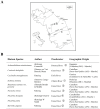Molecular tools for the selective detection of nine diatom species biomarkers of various water quality levels
- PMID: 26006124
- PMCID: PMC4454981
- DOI: 10.3390/ijerph120505485
Molecular tools for the selective detection of nine diatom species biomarkers of various water quality levels
Abstract
Our understanding of the composition of diatom communities and their response to environmental changes is currently limited by laborious taxonomic identification procedures. Advances in molecular technologies are expected to contribute more efficient, robust and sensitive tools for the detection of these ecologically relevant microorganisms. There is a need to explore and test phylogenetic markers as an alternative to the use of rRNA genes, whose limited sequence divergence does not allow the accurate discrimination of diatoms at the species level. In this work, nine diatom species belonging to eight genera, isolated from epylithic environmental samples collected in central Italy, were chosen to implement a panel of diatoms covering the full range of ecological status of freshwaters. The procedure described in this work relies on the PCR amplification of specific regions in two conserved diatom genes, elongation factor 1-a (eEF1-a) and silicic acid transporter (SIT), as a first step to narrow down the complexity of the targets, followed by microarray hybridization experiments. Oligonucleotide probes with the potential to discriminate closely related species were designed taking into account the genetic polymorphisms found in target genes. These probes were tested, refined and validated on a small-scale prototype DNA chip. Overall, we obtained 17 highly specific probes targeting eEF1-a and SIT, along with 19 probes having lower discriminatory power recognizing at the same time two or three species. This basic array was validated in a laboratory setting and is ready for tests with crude environmental samples eventually to be scaled-up to include a larger panel of diatoms. Its possible use for the simultaneous detection of diatoms selected from the classes of water quality identified by the European Water Framework Directive is discussed.
Keywords: diatoms; ecological status; freshwater; microarrays; oligonucleotide probes.
Figures






Similar articles
-
Molecular detection of a potentially toxic diatom species.Int J Environ Res Public Health. 2015 May 6;12(5):4921-41. doi: 10.3390/ijerph120504921. Int J Environ Res Public Health. 2015. PMID: 25955528 Free PMC article.
-
Development of molecular tools for the detection of freshwater diatoms.J Microbiol Methods. 2011 Jan;84(1):33-40. doi: 10.1016/j.mimet.2010.10.008. Epub 2010 Oct 16. J Microbiol Methods. 2011. PMID: 20955737
-
Phytochip: development of a DNA-microarray for rapid and accurate identification of Pseudo-nitzschia spp and other harmful algal species.J Microbiol Methods. 2015 May;112:55-66. doi: 10.1016/j.mimet.2015.03.002. Epub 2015 Mar 10. J Microbiol Methods. 2015. PMID: 25765159
-
Comments on recent progress toward reconstructing the diatom phylogeny.J Nanosci Nanotechnol. 2005 Jan;5(1):57-62. doi: 10.1166/jnn.2005.007. J Nanosci Nanotechnol. 2005. PMID: 15762161 Review.
-
Effects of pesticides on freshwater diatoms.Rev Environ Contam Toxicol. 2010;203:87-103. doi: 10.1007/978-1-4419-1352-4_2. Rev Environ Contam Toxicol. 2010. PMID: 19957117 Review.
Cited by
-
Current Status of Omics in Biological Quality Elements for Freshwater Biomonitoring.Biology (Basel). 2023 Jun 28;12(7):923. doi: 10.3390/biology12070923. Biology (Basel). 2023. PMID: 37508354 Free PMC article. Review.
-
Diatoms recovery from wastewater: Overview from an ecological and economic perspective.J Water Process Eng. 2021 Feb;39:101705. doi: 10.1016/j.jwpe.2020.101705. Epub 2020 Oct 16. J Water Process Eng. 2021. PMID: 38620319 Free PMC article.
-
Molecular detection of a potentially toxic diatom species.Int J Environ Res Public Health. 2015 May 6;12(5):4921-41. doi: 10.3390/ijerph120504921. Int J Environ Res Public Health. 2015. PMID: 25955528 Free PMC article.
References
-
- Nelson D.M., Treguer P., Brzezinski M.A., Leynaert A., Queguiner B. Production and dissolution of biogenic silica in the ocean: Revised global estimates, comparison with regional data and relationship to biogenic sedimentation. Glob. Biogeochem. Cycle. 1995;9:359–372. doi: 10.1029/95GB01070. - DOI
-
- Mann D.G. The species concept in diatoms. Phycologia. 1999;38:437–495. doi: 10.2216/i0031-8884-38-6-437.1. - DOI
Publication types
MeSH terms
Substances
LinkOut - more resources
Full Text Sources
Other Literature Sources
Miscellaneous

